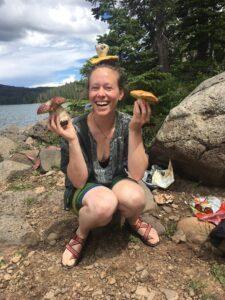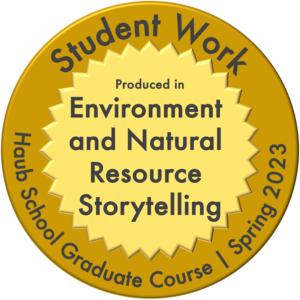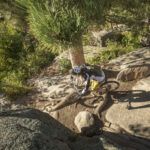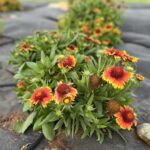The power of mushroom hunting as both outdoor recreation and community science
By Shelby Nivitanont
While off-path and crouching at the base of a stoic fir, I took in my surroundings with an exhalation and fresh eyes. Huge, ruby-red mushroom caps pushed up through the earth around me—countless Boletus rubriceps, or Rocky Mountain porcini. I hadn’t intended to search for mushrooms that day; I had scurried off path while hiking in Wyoming to find a secluded spot to pee. But the forest had other plans for me, and luckily, I already had a permit to forage on public lands. With unbounded excitement but limited pocket space, I took off my shirt and began collecting mushrooms in an improvised sack. I silently thanked nature for her bounty as I selected various boletus, hedgehogs, and chanterelles from the forest floor.

The study of nature is for everyone. Even someone with no formal science education can study field guides and learn to identify mushrooms, finding a new way to get outside and connect with nature in the process. Also, the study of nature needs everyone. There just aren’t enough professional mycologists —scientists who study fungi—to fully survey and understand our wildlands. Local and national science outreach organizations come in to fill the gap. They host community science projects where amateur naturalists can responsibly contribute their observations in ways that scientists and conservationists can analyze. Through community science, amateur mycophiles provide the human-power to collect the mass of data required to improve our broader ecological understanding of fungi.
“People just want to get out into the woods,” half-jokes Jon Sommer, president of the Colorado Mycological Society, a group that hosts mushroom hunting forays in the Rocky Mountains. To him, mushroom hunting is a great form of outdoor recreation. In the short and fast summer of the Rockies, Sommer argues, everyone either wants a reason to be outside or they already are outside. Exemplars of science outreach, like local mushroom clubs, the Biodiversity Institute at the University of Wyoming, and iNaturalist, organize events to empower community members to enjoy and discover the West. When mushroom hunters connect with a community science project close to their heart, a fun Saturday afternoon hike also becomes an opportunity to accurately document species in the region.
During organized group forays, like those hosted by the Colorado Mycological Society, participants can collectively catalog over 500 species of fungi in one morning. A mushroom guide, often a self-taught amateur mycologist like me, helps identify all the interesting fungi and whether they are edible or toxic, native or invasive, and parasitic or mycorrhizal. Sommers emphasizes the importance of amateur and professional mycologists working together for advancements in science.
At the University of Wyoming Biodiversity Institute, scientists work with the public to further the understanding and conservation of biodiversity through a variety of community science projects. “We’re trying to connect community members with the research that’s going on at the University, primarily,” says Dorothy Tuthill, who recently retired as the institute’s associate director and education coordinator. One example is the Wyoming BioBlitz, which is curated and taught by local scientists. The 24-hour event feeds a sense of curiosity and discovery by encouraging the community to observe everything around them, from the moose to the millipede, and yes, the mushroom.
But are observations from amateur naturalists reliable enough to support science? One study from the University of Wyoming found that, at least for amphibians, trained community scientists’ ability to correctly identify and detect species was on par with that of professional biologists. “Agreement in species detected by community scientists and biologists ranged from 77% to 99%,” the researchers wrote about long-term tiger salamander monitoring in Laramie, Wyoming.
Although it is impossible to predict all potential impacts of community science, one example reveals how in the mushroom world, simply monitoring ecological trends can save lives. Steve Miller, botany professor at the University of Wyoming, explains that prior to three years ago if you had asked a Rocky Mountain mushroom hunter about poisonous mushrooms, they would have assured you that Amanita phallodies, commonly known as the death cap, was not a danger. In fact, it wasn’t even in the local guidebooks because A. phallodies is native to Europe and had never been found in the United States. But then, Miller recalls, two San Francisco Mycological Society members unknowingly ingested the death cap, fell seriously ill, and required emergency liver transplants. Last year, an amateur mycologist and community scientist in Boise, Idaho, documented the non-native death cap mushroom in Idaho. Each season, the death cap’s range extends, and no one is sure where it will pop up next. The uncertainty is in part because “the [Amanita phalloides] appears to be switching hosts, as it is an ectomycorrhizal fungus symbiotically associated with trees,” says Miller. In other words, associating host trees with a certain fungus—a standard method for identifying mushrooms—has not proven trustworthy for spotting the death cap. Tracking fungi’s location with community science can prevent deaths and aid in a better understanding of these toxic mushrooms, because there is still much to learn about the death cap.
“What we know, in general, about most groups of mushrooms is that the distribution of fungi is directly related to the distribution of mycologists,” Sommer explains. That means that where there are people who study mushrooms, we know a lot about those mushrooms. The bottleneck is people, data, and funding. With voluntary community scientists, all three problems have potential solutions. “That’s now changing because we have mushroom clubs all over the world—well over 200 clubs in the US alone.”
Solo naturalists can contribute to online community science through apps like iNaturalist, where users and experts visually verify the genus based on pictures and locations. After emptying my shirt full of mushrooms, I logged my day’s bounty in iNaturalist to confirm the fungi identifications and to share data. As it traveled the digital airwaves, I hoped that my contribution would assist professional mycologists in understanding the region and tree associations of the rocky mountain porcini—a delicious mushroom that paired well that evening with goat cheese, roast chicken, a cabernet franc, and, as with all delicious meals, good friends.
Shelby Nivitanont is a mycophile, an outdoor recreationalist, and a law librarian at the University of Wyoming College of Law.
Banner photo: Boletus rubriceps, photographed in the White Mountains, Arizona, USA. (Alan Rockefeller, CC BY-SA 4.0).




Pretty darn good information and well written.
This is a very interesting and informative article.